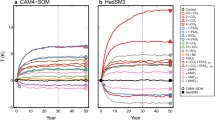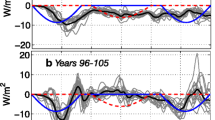Abstract.
The sensitivity of an idealized climate system model consisting of an atmospheric GCM coupled to an oceanic upper mixed layer on an aquaplanet is analyzed. There is no seasonal cycle and the solar radiation is taken to be symmetric about the equator. The system is integrated with the observed CO2 (330 ppm) until it reaches a quasi-equilibrium climate. To study the sensitivity we double the CO2 and again integrate until the system reaches a new equilibrium climate. To simplify the linear analysis we assume that the atmosphere is always in quasi-equilibrium (typical atmospheric adjustment times being much shorter than that of the oceanic upper mixed layer). We introduce a linear surface energy budget sensitivity (or response) operator consisting of a Jacobian matrix of the surface budget with respect to the surface temperature. The operator is used to construct a linear estimate of the surface temperature change that results from the CO2 doubling. It is found that the temperature response obtained from the linear extimate compares well with the results of the full 3D run. The shape of the response looks very similar to that of the least stable mode of the linear surface budget sensitivity operator. The importance of different components of the initial forcing at the surface is discussed. The role of the individual components in determining the final equilibrium climate is also studied.















Similar content being viewed by others
References
Alexeev VA, Bates JR (1999) GCM experiments to test a proposed dynamical stabilizing mechanism in the climate system. Tellus 51A: 630–651
Arrhenius S (1896) On the influence of carbonic acid in the air upon the temperature of the ground. Philos Mag Ser 5(41): 237–276
Bates JR (1999) A dynamical stabilizer in the climate system: a mechanism suggested by a simple model. Tellus 51A: 349–372
Bates JR, Moorthi S, Higgins RW (1993) A global multilevel atmospheric model using a vector semi-Lagrangian finite-difference scheme. Part I: adiabatic formulation. Mon Weather Rev 121: 244–263
Boer G (1993) Climate change and the regulation of the surface moisture and energy budgets. Clim Dyn 8: 225–239
Harshvardhan DR, Randall DA, Corsetti TG (1992) A fast radiation parametrization for atmospheric circulation models. J Geophys Res 92: 1009–1016
Helfand HM, Labraga JC (1988) Design of a non-singular level 2.5 second order closure model for the prediction of atmospheric turbulence. J Atmos Sci 45: 113–132
Houghton JT, et al (eds) (2001) IPCC, Climate: the scientific basis, Cambridge University Press, Cambridge, UK
Huber M, Sloan LC (2001) Heat transport, deep waters, and thermal gradients: coupled simulation of an Eocene greenhouse climate. Geophys Res Lett 28(18): 3481–3484
Mitchell JFB (2000) Prediction and detection of anthropogenic climate change. In: Pearce RP (ed) Meteorology at the millenium. Academic Press, New York pp 333
Moller F (1963) On the influence of changes in the CO2 concentration on the radiation balance of the earth's surface and on the climate. J Geophys Res 68: 3877–3886
Moorthi S, Suarez MJ (1992) Relaxed Arakawa-Schubert: a parametrization of moist convection for general circulation models. Mon Weather Rev 120: 978–1002
Moorthi S, Higgins RW, Bates JR (1995) A global multilevel atmospheric model using a vector semi-Lagrangian finite-difference scheme. Part II: version with physics. Mon Weather Rev 123: 1523–1541
Newell RE, Dopplick TG (1979) Questions concerning the possible influence of anthropogenic CO2 on atmospheric temperature. J Appl Meteorol 18: 822–825
North GR, Yip K-J, Leung L-Y, Chervin RM (1992) Forced and free variations of the surface temperature field in a general circulation model. J Clim 5: 227–239
North GR, Bell RE, Hardin JW (1993) Fluctuation dissipation in a general circulation model. Clim Dyn 8: 259–264
Randall D, et al (1992) Intercomparison and interpretation of surface energy fluxes in atmospheric general circulation models. J Geophys Res 97: 3711–3724
Ramanathan V (1981) The role of ocean–atmosphere interaction in the CO2 climate problem. J Atmos Sci 38: 918–930
Ramanathan V, Crutzen PJ, Kiehl JT, Rosenfeld D (2001) Aerosols, climate and the hydrological cycle. Science 294: 2119–2124
Rosen RD, Gutowski WJ (1992) Response of zonal winds and atmospheric angular-momentum to a doubling of CO2. J Clim 5: 1391–1404
Räisänen J (1997) CO2 – and aerosol-induced changes in vertically integrated zonal momentum budget in a GCM experiment. J Clim 11: 625–639
Sarachik ED (1978) Tropical sea surface temperature: an interactive one-dimensional atmosphere–ocean model. Dyn Atmos Oceans 2: 455–469
Tackacs L, Molod A, Wang T (1994) Documentation of the Goddard earth observing system (GEOS) general circulation model. Version 1. NASA Tech Memo 104606, vol 1
Vavrus S, Gallimore R, Liu Z (2000) A mixed-flux equilibrium asynchronous coupling scheme for accelerating convergence in ocean–atmosphere models. Clim Dyn 16: 821–831
Acknowledgements.
The author would like to thank J.R. Bates for many stimulating and useful discussions and G.R. North for pointing out similarities between our results and those of his earlier papers. This work was supported by the Danish National Research Foundation, when the author was employed at the Danish Center for Earth System Science.
Author information
Authors and Affiliations
Corresponding author
Appendix
Appendix
- AM::
-
angular momentum
- B Srf ::
-
F S – F I – F L – F H
- B TOA ::
-
budget at the top-of-the-atmosphere
- c W ::
-
heat capacity of a unit mass of water, 4187 J/kg
- F S ::
-
net downward solar radiative flux at the surface
- F I ::
-
net upward longwave flux at the surface
- F L ::
-
latent heat flux
- F H ::
-
sensible heat flux
- (F L ) w ::
-
wind component of the latent heat flux response to changes in SST
- (F L ) h ::
-
humidity component of the latent heat flux response to changes in SST
- (F H ) T ::
-
temperature component of the sensible heat flux response to changes in SST
- GCM::
-
general circulation model
- H::
-
depth of the oceanic upper mixed layer, 50 m
- EquationSource% MathType!MTEF!2!1!+- % feaaeaart1ev0aaatCvAUfeBSjuyZL2yd9gzLbvyNv2CaerbuLwBLn % hiov2DGi1BTfMBaeXatLxBI9gBaerbd9wDYLwzYbItLDharqqtubsr % 4rNCHbGeaGqiVu0Je9sqqrpepC0xbbL8F4rqqrFfpeea0xe9Lq-Jc9 % vqaqpepm0xbba9pwe9Q8fs0-yqaqpepae9pg0FirpepeKkFr0xfr-x % fr-xb9adbaqaaeGaciGaaiaabeqaamaabaabaaGcbaWefv3ySLgznf % gDOfdaryqr1ngBPrginfgDObYtUvgaiuaacqWFBeIuaaa!4086! \( {\cal R}\) ::
-
matrix of the surface budget response operator
- EquationSource% MathType!MTEF!2!1!+- % feaaeaart1ev0aaatCvAUfeBSjuyZL2yd9gzLbvyNv2CaerbuLwBLn % hiov2DGi1BTfMBaeXatLxBI9gBaerbd9wDYLwzYbItLDharqqtubsr % 4rNCHbGeaGqiVu0Je9sqqrpepC0xbbL8F4rqqrFfpeea0xe9Lq-Jc9 % vqaqpepm0xbba9pwe9Q8fs0-yqaqpepae9pg0FirpepeKkFr0xfr-x % fr-xb9adbaqaaeGaciGaaiaabeqaamaabaabaaGcbaWefv3ySLgznf % gDOfdaryqr1ngBPrginfgDObYtUvgaiuaacqWFBeIudaWgaaWcbaGa % aiikaiaadofacaGGSaGaamysaiaacYcacaWGmbGaaiilaiaadIeaca % GGPaaabeaaaaa!475F! \( {\cal R}_{(S,I,L,H)} \) ::
-
components of SBSO matrix, corresponding to F S , F I , F L and F H sensitivity to changes in SST
- EquationSource% MathType!MTEF!2!1!+- % feaaeaart1ev0aaatCvAUfeBSjuyZL2yd9gzLbvyNv2CaerbuLwBLn % hiov2DGi1BTfMBaeXatLxBI9gBaerbd9wDYLwzYbItLDharqqtubsr % 4rNCHbGeaGqiVu0Je9sqqrpepC0xbbL8F4rqqrFfpeea0xe9Lq-Jc9 % vqaqpepm0xbba9pwe9Q8fs0-yqaqpepae9pg0FirpepeKkFr0xfr-x % fr-xb9adbaqaaeGaciGaaiaabeqaamaabaabaaGcbaWefv3ySLgznf % gDOfdaryqr1ngBPrginfgDObYtUvgaiuaacqWFBeIudaWgaaWcbaGa % aiikaiaadYeacaGGSaGaamisaiaacMcacaWG3baabeaaaaa!4555! \( {\cal R}_{(L,H)w} \) ::
-
wind components of EquationSource% MathType!MTEF!2!1!+- % feaaeaart1ev0aaatCvAUfeBSjuyZL2yd9gzLbvyNv2CaerbuLwBLn % hiov2DGi1BTfMBaeXatLxBI9gBaerbd9wDYLwzYbItLDharqqtubsr % 4rNCHbGeaGqiVu0Je9sqqrpepC0xbbL8F4rqqrFfpeea0xe9Lq-Jc9 % vqaqpepm0xbba9pwe9Q8fs0-yqaqpepae9pg0FirpepeKkFr0xfr-x % fr-xb9adbaqaaeGaciGaaiaabeqaamaabaabaaGcbaWefv3ySLgznf % gDOfdaryqr1ngBPrginfgDObYtUvgaiuaacqWFBeIudaWgaaWcbaGa % aiikaiaadYeacaGGSaGaamisaiaacMcaaeqaaaaa!4459! \( {\cal R}_{(L,H)} \)
- EquationSource% MathType!MTEF!2!1!+- % feaaeaart1ev0aaatCvAUfeBSjuyZL2yd9gzLbvyNv2CaerbuLwBLn % hiov2DGi1BTfMBaeXatLxBI9gBaerbd9wDYLwzYbItLDharqqtubsr % 4rNCHbGeaGqiVu0Je9sqqrpepC0xbbL8F4rqqrFfpeea0xe9Lq-Jc9 % vqaqpepm0xbba9pwe9Q8fs0-yqaqpepae9pg0FirpepeKkFr0xfr-x % fr-xb9adbaqaaeGaciGaaiaabeqaamaabaabaaGcbaWefv3ySLgznf % gDOfdaryqr1ngBPrginfgDObYtUvgaiuaacqWFBeIudaWgaaWcbaGa % amitaiaadIgaaeqaaaaa!4270! \( {\cal R}_{Lh} \) ::
-
humidity components of EquationSource% MathType!MTEF!2!1!+- % feaaeaart1ev0aaatCvAUfeBSjuyZL2yd9gzLbvyNv2CaerbuLwBLn % hiov2DGi1BTfMBaeXatLxBI9gBaerbd9wDYLwzYbItLDharqqtubsr % 4rNCHbGeaGqiVu0Je9sqqrpepC0xbbL8F4rqqrFfpeea0xe9Lq-Jc9 % vqaqpepm0xbba9pwe9Q8fs0-yqaqpepae9pg0FirpepeKkFr0xfr-x % fr-xb9adbaqaaeGaciGaaiaabeqaamaabaabaaGcbaWefv3ySLgznf % gDOfdaryqr1ngBPrginfgDObYtUvgaiuaacqWFBeIudaWgaaWcbaGa % amitaaqabaaaaa!4183! \( {\cal R}_L \)
- EquationSource% MathType!MTEF!2!1!+- % feaaeaart1ev0aaatCvAUfeBSjuyZL2yd9gzLbvyNv2CaerbuLwBLn % hiov2DGi1BTfMBaeXatLxBI9gBaerbd9wDYLwzYbItLDharqqtubsr % 4rNCHbGeaGqiVu0Je9sqqrpepC0xbbL8F4rqqrFfpeea0xe9Lq-Jc9 % vqaqpepm0xbba9pwe9Q8fs0-yqaqpepae9pg0FirpepeKkFr0xfr-x % fr-xb9adbaqaaeGaciGaaiaabeqaamaabaabaaGcbaWefv3ySLgznf % gDOfdaryqr1ngBPrginfgDObYtUvgaiuaacqWFBeIudaWgaaWcbaGa % amisaiaadsfaaeqaaaaa!4258! \( {\cal R}_{HT} \) ::
-
temperature components of EquationSource% MathType!MTEF!2!1!+- % feaaeaart1ev0aaatCvAUfeBSjuyZL2yd9gzLbvyNv2CaerbuLwBLn % hiov2DGi1BTfMBaeXatLxBI9gBaerbd9wDYLwzYbItLDharqqtubsr % 4rNCHbGeaGqiVu0Je9sqqrpepC0xbbL8F4rqqrFfpeea0xe9Lq-Jc9 % vqaqpepm0xbba9pwe9Q8fs0-yqaqpepae9pg0FirpepeKkFr0xfr-x % fr-xb9adbaqaaeGaciGaaiaabeqaamaabaabaaGcbaWefv3ySLgznf % gDOfdaryqr1ngBPrginfgDObYtUvgaiuaacqWFBeIudaWgaaWcbaGa % amisaaqabaaaaa!417F! \( {\cal R}_H \)
- SBRO::
-
surface budget response operator
- SST::
-
sea surface temperature
- S TOA ::
-
downward solar radiative flux at the TOA
- T S ::
-
surface temperature
- TOA::
-
top of the atmosphere
- ρ W ::
-
density of water, 1000 kg/m3
- Λ::
-
a set of external parameters of the system (or just one parameter)
- δΛ::
-
perturbation to Λ
- λ i ::
-
i-th eigenvalue of the surface budget response operator
- φ i ::
-
i-th eigenmode of the surface budget response operator
- τ i = 1/λ i ::
-
e-folding time of the i-th eigenmode of the SBRO
Rights and permissions
About this article
Cite this article
Alexeev, V.A. Sensitivity to CO2 doubling of an atmospheric GCM coupled to an oceanic mixed layer: a linear analysis. Climate Dynamics 20, 775–787 (2003). https://doi.org/10.1007/s00382-003-0312-x
Received:
Accepted:
Published:
Issue Date:
DOI: https://doi.org/10.1007/s00382-003-0312-x




